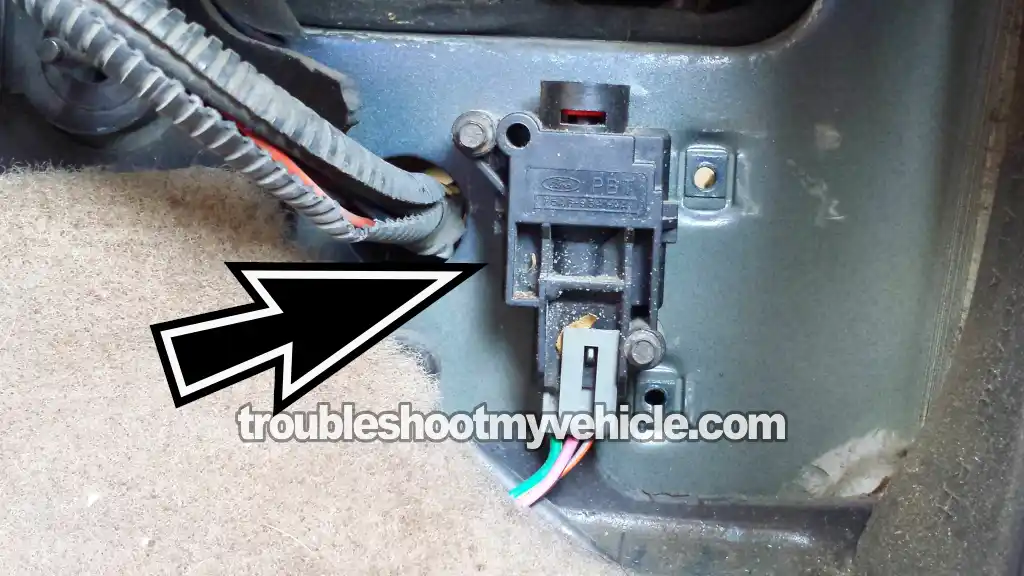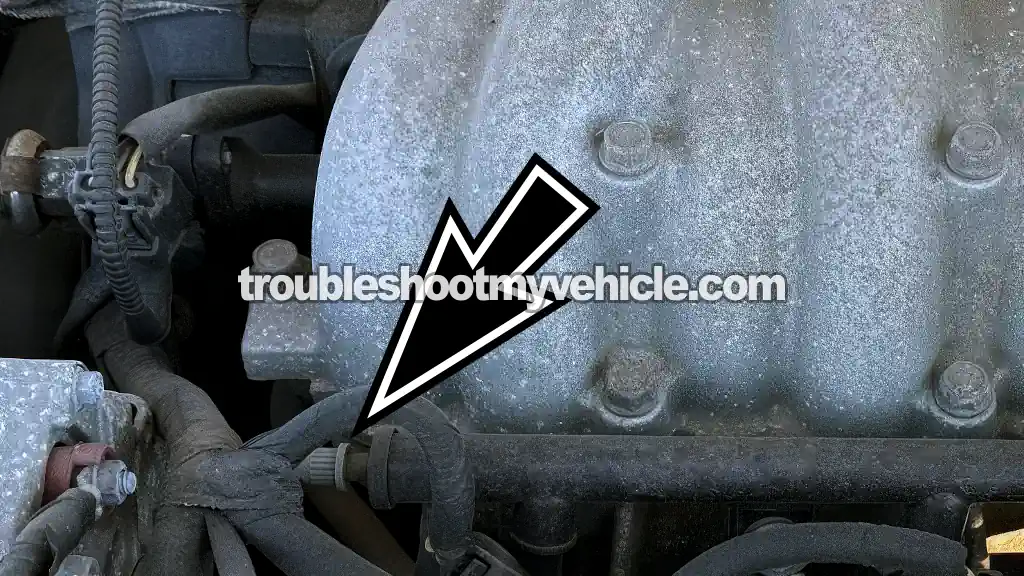
In this tutorial, I'm going to show you how to test the fuel pump's pressure with a fuel pressure gauge on the 2000 3.0L V6 (OHV) Ford Taurus and Mercury Sable.
This fuel pressure test will help you figure out if an engine performance problem or a no-start issue is being caused by a weak or bad fuel pump.
I'm also going to explain how to do a starting fluid test to see if a no-start problem is tied to a fuel delivery issue.
NOTE: The 2000 3.0L V6 Ford Taurus and Mercury Sable come equipped with a Fuel Pump Driver Module (FPDM). This is the module that activates the fuel pump.
Contents of this tutorial:
APPLIES TO: This tutorial applies to the following vehicles:
- 3.0L V6 (OHV) Ford Taurus: 2000.
- 3.0L V6 (OHV) Mercury Sable: 2000.
OTHER FUEL PRESSURE TESTS:
- How To Test The Fuel Pump (1990-1999 3.0L V6 Ford Taurus, Mercury Sable).
- How To Test The Fuel Pump (2001-2002 3.0L V6 Ford Taurus, Mercury Sable).
- How To Test The Fuel Pump (2003 3.0L V6 Ford Taurus, Mercury Sable).
FUEL PUMP DRIVER MODULE (FPDM) TESTS:
Symptoms Of A Bad Fuel Pump
It's been my experience over the years working on cars that fuel pumps usually fail in one of two ways:
- Complete failure: The fuel pump simply stops working and the fuel injectors don't get any fuel.
- Weak output: The fuel pump is running, but it's only sending enough fuel to get the engine started —and the engine doesn't run like it should.
Since the fuel pump is such a critical component to start and keep the engine running, when it fails completely or starts to fail, you're going to see one or more of the following performance issues:
- Engine cranks but doesn't start.
- Lean air/fuel mixture trouble codes.
- Rough idle.
- Engine starts after extended cranking.
- Lack of power when accelerating the vehicle down the road.
- Back-fires thru' the intake manifold when accelerating your Ford Taurus (Mercury Sable) down the road.
Since quite a few things can cause an engine not to start or run poorly, it's important to check the fuel pump's pressure output. That way you can know if the fuel pump is behind the problem, or if it's something else.
Where To Buy A Fuel Pressure Test Gauge
The cool thing about the fuel pressure test on the 2000 3.0L (OHV) V6 Taurus and Sable is that the fuel system already comes equipped with a fuel pressure test port (Schrader valve). This is where you can hook up a fuel pressure gauge and check fuel pressure.
If you don't have a gauge, I recommend the following fuel pressure test kits. They're reliable, they won't cost you an arm and a leg, and they come with the test port adapter you'll need for your Ford Taurus or Mercury Sable.
Disclosure: As an Amazon Associate, I earn from qualifying purchases. If my tutorials help you, using these links is an easy way to support the site at no extra cost to you. Thank you!
Fuel Pressure Specifications
The fuel pressure specifications with the key on engine off (KOEO) and key on engine running (KOER) are:
| Year | KOEO | KOER |
|---|---|---|
| 2000 | 37-43 PSI | 26-45 PSI |
TEST 1: Checking Fuel Pressure With A Fuel Pressure Gauge
To get started, we're going to connect the fuel pressure gauge to the Schrader valve on the fuel injector rail.
As you can see in the photo above, the Schrader valve is on the injector rail for cylinders 4, 5, and 6 —the ones that face the radiator. If you follow that fuel injector rail, you'll see the Schrader valve at the end closest to the alternator.
Once we check fuel pressure, I'll walk you through how to interpret your test results below.
If you don't have a fuel pressure gauge, take a look at the section: Where To Buy A Fuel Pressure Test Gauge.
FUEL PUMP INERTIA SWITCH CHECK: If you haven't checked the fuel pump inertia switch yet, make sure you do that first. If the switch has been tripped, the engine isn't going to start, since a tripped inertia switch cuts power to the fuel pump. To learn more about it —and where it's located on your specific Ford Taurus or Mercury Sable— see this article: Fuel Pump Inertia Switch: Location, Function, And Reset (1991-2007 3.0L V6 Ford Taurus, Mercury Sable).
Alright, let's get this show on the road:
- 1
Place a shop towel around the Schrader valve. The shop towel's job is to absorb any fuel that may leak when doing step 2.
To see the location of the Schrader valve, go here: Location Of The Schrader Valve. - 2
Connect the fuel pressure gauge to the Schrader valve on your 3.0L Ford Taurus's fuel injector rail.
- 3
When ready, ask your helper to cycle the key on and off but don't crank the engine while you check for fuel leaks at the fuel gauge connection (at the Schrader valve).
If you see fuel leaking, tighten the fuel pressure a bit more (by hand only) to eliminate them.
ENGINE DOES NOT START: Key On Engine Off (KOEO) Test:
- 4
Crank the engine as you observe the fuel pressure gauge.
- 5
Your fuel pressure gauge should register 37-43 PSI if the fuel pump is OK.
ENGINE STARTS AND RUNS: Key On Engine Running (KOER) Test:
- 4
Crank and start the engine as you observe the fuel pressure gauge.
- 5
Your fuel pressure gauge should register 26-45 PSI if the fuel pump is OK.
Let's take a look at what your results mean:
CASE 1: The fuel pressure gauge registered 0 PSI. This confirms that your Taurus or Sable's no-start problem is being caused by a lack of fuel.
This usually means the fuel pump is toast and needs to be replaced. But your 2000 Ford Taurus or Mercury Sable also comes equipped with a Fuel Pump Driver Module (FPDM), and these bad boys are known for failing. So even though you've got a zero PSI fuel pressure reading, your next step is to test the FPDM and make sure it hasn't fried and behind's the fuel pump's 0 PSI output.
CASE 2: The fuel pressure gauge registered below spec. This means the fuel pump is failing —but only if there aren't any Fuel Pump Driver Module (FPDM) or Fuel Rail Pressure (FRP) sensor diagnostic trouble codes stored in the PCM's memory.
If you do have any of those codes, you'll need to troubleshoot them first before blaming the fuel pump. If you don't, then the pump is failing and needs to be replaced.
CASE 3: The fuel pressure gauge registered the specified fuel pressure. This is the correct and expected result, and it tells you the fuel pump is doing its job.
If you're troubleshooting a no-start or performance issue, you can now rule the fuel pump out as the cause.
TEST 2: Using Starting Fluid To Confirm Lack Of Fuel

The starting fluid test is a classic engine no-start diagnostic test that's been around forever —going all the way back to the days of carburetors. It's also one of the very first tests I learned when I started working on cars.
The idea behind the starting fluid test is simple: figure out if the no-start problem is being caused by a lack of fuel. But before you do it, the most important step is to make sure all six spark plug wires are actually delivering spark to the spark plugs. And this has to be checked with a spark tester.
Once you've confirmed that spark is reaching all six cylinders, the next step is to loosen the air intake duct from the throttle body, spray a little starting fluid into the intake, and have a helper crank the engine. If the engine fires up and runs for a few seconds —until the starting fluid is burned off— then you know a fuel delivery issue is behind the no-start.
But again, the key to getting a correct result from this test is to first make sure all cylinders are getting spark.
IMPORTANT: This is a very fast and easy test but you do have to take one very important safety precaution and this is to reconnect the air intake duct after spraying starting fluid down the throttle bore (although you don't have to fasten it). This will prevent any backfire, that might occur, from scaring the heck out of you when cranking the engine.
Let's get testing:
- 1
Remove the intake air duct from the throttle body. You don't have to completely remove it, since you'll have to reconnect it in one of the next steps.
- 2
Open the throttle plate and spray starting fluid down the bore.
As a safety precaution reconnect the air duct after you have sprayed a good squirt of starting fluid (but you don't have to tighten the air duct's hose clamp). - 3
Crank the engine once the air duct is back on and you're clear of the engine compartment.
- 4
You'll get one of two results with this test:
1.) The engine will start momentarily and after a few seconds will die or.
2.) The engine will only crank but not start at all.
OK, let's find out what your results mean:
CASE 1: The engine started and ran for a few seconds. This tells you that a lack of fuel is causing the engine no-start. Most of the time, this points to a bad fuel pump.
If I were in your shoes, though, I'd still check fuel pressure with a gauge just to be sure. For the fuel pressure test, go to: TEST 1: Checking Fuel Pressure With A Fuel Pressure Gauge.
CASE 2: The engine didn't start, not even momentarily. This tells you that a lack of fuel isn't the reason the engine won't start. Of course, this is only true if you've confirmed all six spark plug wires are delivering spark to their cylinders.
Fuel Pump Inertia Switch

As you're probably already aware, your Ford Taurus (Mercury Sable) comes equipped with a fuel pump inertia switch. This switch is a safety device that de-activates the fuel pump in case of an impact and once it activates, you have to manually reset it. It's usually located on the right side (passenger side) of the dash, below the glove box or in the trunk of the car.
When the inertia switch is jolted into action, the engine is not gonna' start. It'll crank but not start, which can lead you to believe that the fuel pump is bad.
Although it's designed to activate during a severe impact caused by an automobile accident, sometimes it gets activated by less than severe impacts. This means that it's always a good idea to check and reset the inertia switch whenever testing the fuel pump.
Resetting the fuel pump inertia switch simply involves pushing down on the button located on top of the inertia switch till it bottoms out.
More 3.0L V6 Ford Taurus Diagnostic Tutorials
You can find a complete list of 3.0L V6 Ford Taurus and Mercury Sable diagnostic tutorials in this index:
Here's a sample of the diagnostic tutorials you'll find in the index:
- How To Do And Interpret An Engine Compression Test (1990-2007 3.0L V6 Ford Taurus, Mercury Sable).
- How To Test For A Blown Head Gasket (1990-2007 3.0L V6 Ford Taurus, Mercury Sable).
- How To Test The MAF Sensor (1996-1999 3.0L V6 Ford Taurus, Mercury Sable).
- How To Test The MAF Sensor (2000-2003 3.0L V6 Ford Taurus, Mercury Sable).

If this info saved the day, buy me a beer!






